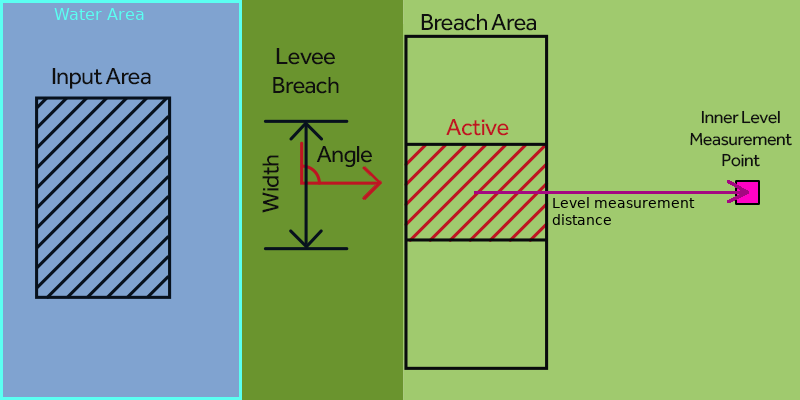Breach model (Water Overlay): Difference between revisions
Jump to navigation
Jump to search
No edit summary |
No edit summary |
||
| Line 1: | Line 1: | ||
A Breach | A Breach can be defined as an area and is identified via the [[Breach_height_(Water_Overlay)|BREACH_HEIGHT]] attribute. It can have an input area or external area with a water body outside of the hydrological model. Water can flow through the breach form the input into the Breach area just behind the levee and vise versa. | ||
The breach is simulated as a generic [[Breach_flow_formula_(Water_Overlay)|weir]] with breach characteristics that models the energy loss, the weir input/output is dynamically mapped onto the 2D grid cells. Using the [[Breach_growth_formula_(Water_Overlay)|Verheij–van der Knaap]] method the breach can also grow over time from phase one deepening to phase two widening. Below a simple schematic of the different breach elements. | The breach is simulated as a generic [[Breach_flow_formula_(Water_Overlay)|weir]] with breach characteristics that models the energy loss, the weir input/output is dynamically mapped onto the 2D grid cells. Using the [[Breach_growth_formula_(Water_Overlay)|Verheij–van der Knaap]] method the breach can also grow over time from phase one deepening to phase two widening. Below a simple schematic of the different breach elements. | ||
Revision as of 13:27, 12 January 2023
A Breach can be defined as an area and is identified via the BREACH_HEIGHT attribute. It can have an input area or external area with a water body outside of the hydrological model. Water can flow through the breach form the input into the Breach area just behind the levee and vise versa.
The breach is simulated as a generic weir with breach characteristics that models the energy loss, the weir input/output is dynamically mapped onto the 2D grid cells. Using the Verheij–van der Knaap method the breach can also grow over time from phase one deepening to phase two widening. Below a simple schematic of the different breach elements.
Side View
Top View
Features
- The breach can grow over time, based on its initial width, critical speed and inner and outer water level, for more details see Verheij–van der Knaap growth formula.
- With larger breaches the water level inside the breach area can become turbulent. Therefor the inner water level (used for breach growth) is measured at a distance defined in BREACH_MEASUREMENT_DISTANCE_M behind the breach area when an BREACH_ANGLE is provided.
- Instead of using an input area you can also define a fictitious external area, this can represent a larger water body outside the project area, e.g. the entire sea. The external area also has it's own Surface level, Water level and Area.
- If a BREACH_WIDTH attribute is defined, the breach's polygon is intersected with a circle emanating from the center-point of the polygon. It is only in that intersection, called "active", that water will flow in from the input area. The radius of the circle defining the intersection will expand as the breach grows over time.
- Water flowing through the breach will flow in the direction defined by the BREACH_ANGLE attribute, regardless of whether the water flowed onto the breach from elsewhere in the water model, or from the simulated external water body. When no BREACH_ANGLE is defined, water can flow in any direction. Adding this attribute with also convert the breach advection speed (m/s) into the 2D cell of the breach area. It is recommended to always use this attribute for optimal flow.
- If no BREACH_SPEED attribute is defined, the active breach will never grow.
- If no width is defined, the width is assumed to be very large, using the full Breach area polygon.
- The BREACH_HEIGHT attribute can also have multiple values over time, this allows you this simulate the breach vertical growth.
Notes
- The elevation model covered by the entire breach area is lowered to at least the minimum height defined by its BREACH_HEIGHT attribute. This is to prevent the terrain height from interfering with the flow.
- When using breach growth the inner water level is computed from the average value in the active breach area. For optimal flow simulation it is therefor recommended to place the breach area just behind the levee on a flat space.
- Water on a breach area is automatically spread across the entire active breach area equally.
- The inner/outer water levels and breach width are visualized per timeframe on the breach object in the 3D map, these can be very useful to see how the breach is progressing.
- The Base Types Result child overlay can be used to see which part of entire the breach area is considered "active". Breach growth can be seen when checking multiple timeframes.
- You can also optionally change the default breach weir coefficient to model energy loss by adding a WEIR_COEFFICIENT attribute to the Breach area.
- When the water level of in the input area drops over time the flow can also reverse, flowing back into the e.g. the river/sea.






